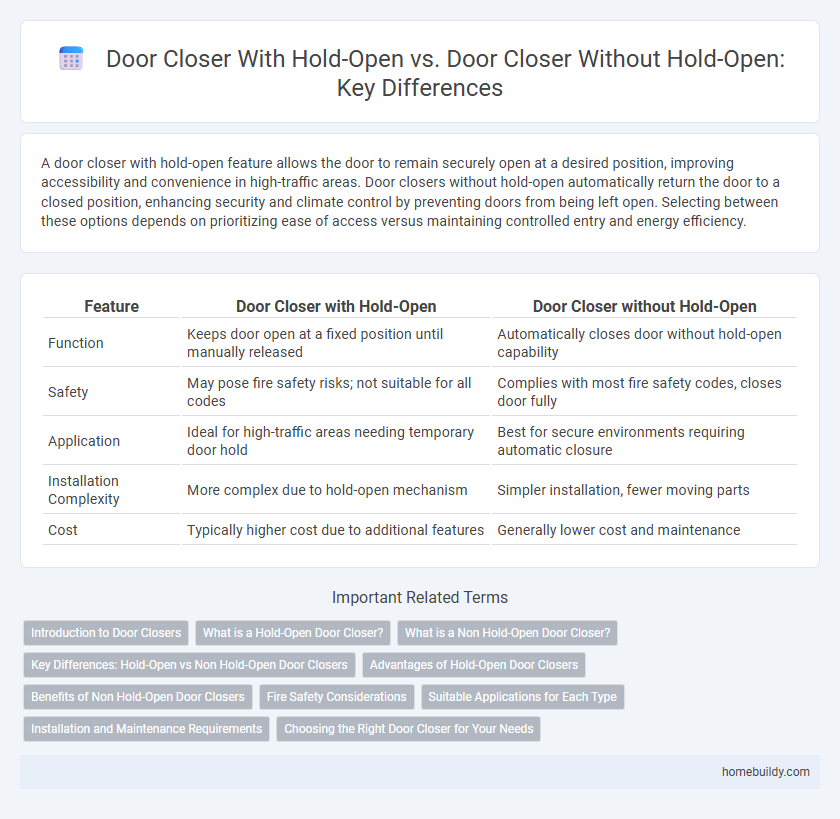A door closer with hold-open feature allows the door to remain securely open at a desired position, improving accessibility and convenience in high-traffic areas. Door closers without hold-open automatically return the door to a closed position, enhancing security and climate control by preventing doors from being left open. Selecting between these options depends on prioritizing ease of access versus maintaining controlled entry and energy efficiency.
Table of Comparison
| Feature | Door Closer with Hold-Open | Door Closer without Hold-Open |
|---|---|---|
| Function | Keeps door open at a fixed position until manually released | Automatically closes door without hold-open capability |
| Safety | May pose fire safety risks; not suitable for all codes | Complies with most fire safety codes, closes door fully |
| Application | Ideal for high-traffic areas needing temporary door hold | Best for secure environments requiring automatic closure |
| Installation Complexity | More complex due to hold-open mechanism | Simpler installation, fewer moving parts |
| Cost | Typically higher cost due to additional features | Generally lower cost and maintenance |
Introduction to Door Closers
Door closers with hold-open feature allow doors to remain open at a set position, ideal for spaces requiring frequent access or ventilation, enhancing convenience and safety. Door closers without hold-open function automatically close the door after opening, providing security and fire protection in compliance with building codes. Selecting between these types depends on the balance between controlled access and regulatory requirements for door operation.
What is a Hold-Open Door Closer?
A hold-open door closer includes a mechanism that keeps the door open at a specific angle until manually released, enhancing convenience in high-traffic areas or accessibility needs. This feature allows the door to remain open without constant pressure, providing ease of movement for users while maintaining control over door closing. In contrast, a door closer without hold-open automatically closes the door after it is opened, ensuring security and fire safety compliance without manual intervention.
What is a Non Hold-Open Door Closer?
A non hold-open door closer is a mechanical device designed to automatically close a door after it has been opened without the ability to hold the door in an open position. This type of door closer provides enhanced security and fire safety by ensuring doors close firmly behind users, preventing unauthorized access and containing fire or smoke. Non hold-open closers are commonly used in commercial buildings and fire-rated doors where automatic closure is critical.
Key Differences: Hold-Open vs Non Hold-Open Door Closers
Door closers with hold-open feature allow doors to stay open at a desired angle for extended periods, enhancing accessibility and convenience in high-traffic areas. Non hold-open door closers automatically close the door after opening, ensuring consistent security and energy efficiency in controlled environments. The choice between them depends on the specific needs for door functionality, safety regulations, and user convenience within the space.
Advantages of Hold-Open Door Closers
Hold-open door closers provide the advantage of allowing doors to remain securely open at a set position, enhancing convenience in high-traffic areas and improving accessibility for individuals with disabilities. They reduce wear and tear on door hardware by preventing the door from constantly swinging closed, extending the lifespan of the door mechanism. This feature also contributes to increased energy efficiency by minimizing unnecessary door closures that can lead to loss of heating or cooling.
Benefits of Non Hold-Open Door Closers
Non hold-open door closers provide enhanced security by ensuring doors close automatically without manual intervention, reducing the risk of unauthorized entry. These closers maintain fire safety compliance by preventing doors from remaining open, effectively containing smoke and flames during emergencies. Their simple design requires less maintenance and minimizes mechanical failures compared to hold-open models, ensuring consistent and reliable door operation.
Fire Safety Considerations
Door closers with hold-open features can compromise fire safety by allowing doors to remain open, potentially enabling the spread of smoke and fire through compartments. In contrast, door closers without hold-open mechanisms ensure automatic door closure, maintaining fire barriers and preventing the rapid progression of fire. Building codes and fire safety regulations often mandate the use of door closers without hold-open functions in fire-rated doors to ensure compliance and occupant safety.
Suitable Applications for Each Type
Door closers with hold-open functionality are ideal for environments requiring temporary door propping, such as hospitals, schools, and retail stores, where accessibility and ease of movement are priorities. Conversely, door closers without hold-open are better suited for fire-rated doors and security-sensitive areas, ensuring automatic closure to maintain safety and compliance. Selecting the appropriate type enhances building safety, accessibility, and operational efficiency.
Installation and Maintenance Requirements
Door closers with hold-open features require precise installation to ensure the hold-open mechanism functions correctly and safely, often involving additional components such as arm brackets or hold-open struts. Maintenance for these units tends to be more involved, requiring regular checks to adjust the hold-open position and inspect for wear to prevent malfunction. In contrast, door closers without hold-open features generally have simpler installation processes and lower maintenance demands, focusing primarily on door speed and latching adjustments without the need for extra hold-open hardware.
Choosing the Right Door Closer for Your Needs
Choose a door closer with hold-open feature when you need to keep doors securely open for extended periods, such as in commercial buildings or healthcare facilities where accessibility is crucial. Door closers without hold-open functionality are ideal for spaces requiring automatic closure to maintain security, fire safety, or energy efficiency. Assess your environment's usage patterns, safety requirements, and regulatory compliance to select the most appropriate door closer type.
door closer with hold-open vs door closer without hold-open Infographic

 homebuildy.com
homebuildy.com